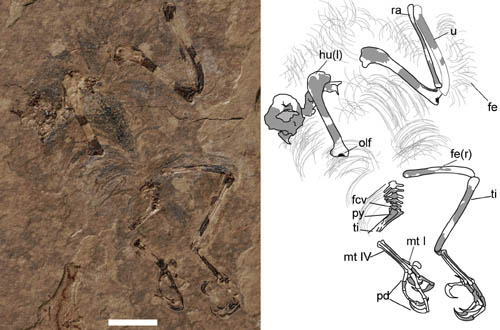First Enantiornithine Bird Found From the Upper Cretaceous of Southern China
Most known Enantiornithes from China are from the Jehol Group (131–120 million years ago), which has yielded numerous and exquisitely preserved Lower Cretaceous birds, and all known Enantiornithes are restricted to northern China. In an article published in the latest issue of Journal of Vertebrate Paleontology 34(1), paleontologists from Institute of Vertebrate Paleontology and Paleoanthropology (IVPP), Chinese Academy of Sciences, reported a new Late Cretaceous avian taxon, Parvavis chuxiongensis, gen. et sp. nov., from Upper Cretaceous lake deposits in Yunnan Province, southern China. The new specimen represents both the first known bird from the Upper Cretaceous of China and the first Mesozoic bird from the southern China, and thus extends the temporal and geographic range of Mesozoic birds in China.
The new specimen is an articulated partial skeleton preserved in a slab and counter slab with feather impressions covering the body cranial to the pygostyle. The skeleton was collected in 2010 from the Jiangdihe Formation at Luojumei Village, Chuxiong City, Yunnan Province, southern China. The litho- and biostratigraphic correlation suggests that the Jiangdihe Formation was deposited during the Late Cretaceous.
Histological study shows that the bones of Parvavis were composed of parallel-fibered bone tissue without lines of arrested growth, indicating that growth rate had slowed but had not stopped at any stage prior to death. The bones also lack the rough surface texture seen in juvenile birds. Therefore, researchers inferred that the new bird was probably close to adult body size at the time of death. As the specimen is surprisingly small, Parvavis helps better understanding the diversity in body size that existed among enantiornithine birds.
A phylogenetic analysis resulted in three most parsimonious trees, the strict consensus tree of which places Parvavis chuxiongensis within Enantiornithes. Parvavis is a small species, with humerus less than half as long as that of Longipteryx, distinguished from other known enantiornithine birds by the following combination of characters: metatarsals II and IV terminate proximal to the entire trochlea of metatarsal III; the trochlea of metatarsal II broader than those of other metatarsals (widely distributed in enantiornithines, e.g., Eoenantiornis, Vescornis); and ungual of digit IV reduced (among other enantiornithines, found only in Vescornis and Qiliania).
"It is notable that Parvavis represents the only known enantiornithine bird form the Upper Cretaceous of China. The fact that our phylogenetic analysis placed Parvavis at the base of a non-longipterygid clade otherwise made up primarily of Early Cretaceous taxa implies an interesting mismatch between phylogeny and stratigraphy, and suggests that southern China might have served in the Late Cretaceous as a refuge for enantiornithines that retained many primitive features", said first author WANG Min, a paleontologist graduate student of the IVPP, "However, this issue needs more investigation, especially rigorous phylogenetic analysis of a larger sample of enantiornithines, ideally including new specimens from the Upper Cretaceous of southern China".
This research was supported by the National Basic Research Program of China (973 Program), and the National Natural Science Foundation of China.

Fig.1 Holotype of Parvavis chuxiongensis (IVPP V18586/1) in photograph (A) and line drawing (B), where shaded parts indicate missing bone. Scale bar equals 10 mm. (Image by WANG Min)

Fig.2 Holotype of Parvavis chuxiongensis (IVPP V18586/2) (counterpart) in photograph and line drawing, where shaded parts indicate missing bone. Scale bar equals 10 mm. (Image by WANG Min)

